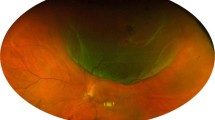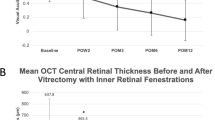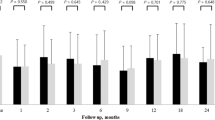Abstract
Objectives
To assess the risk factors for resistance to first-line therapy and long-term response to dexamethasone intravitreal implant (Ozurdex®) of patients with macular oedema (MO) secondary to rhegmatogenous retinal detachment repair (RRDR).
Methods
This was a retrospective, consecutive cohort study conducted in patients who underwent RRDR between January 2014 and December 2020 in the Rothschild Foundation Hospital and experienced postoperative MO (POMO) with a follow-up of at least 18 months.
Results
Of the 1152 patients screened, 36 eyes (3.1%) experienced POMO. The mean follow-up duration was 45.2 months (18.0–80.5 months). Twenty-five eyes (69.4%) were resistant to first-line therapy and received at least one Ozurdex® injection (mean number: 2.7 [1–12]). The multivariate analysis showed an increased risk of resistance in patients who underwent perfluorocarbon liquid (PFCL)-assisted drainage (adjusted odds ratio: 8.65; 95% confidence interval: 1.97–15.33; p = 0.01). Significant differences in best-corrected visual acuity and central macular thickness were found between before Ozurdex® injection and the last follow-up visit: from 0.57 ± 0.47 LogMAR to 0.34 ± 0.32 LogMAR (p = 0.02) and from 483.0 ± 124.0 µm to 354.6 ± 96.5 µm (p = 0.001), respectively. The absence of serous retinal detachment and the presence of hyperreflective foci at baseline were associated with a higher resistance and a poorer response to Ozurdex®. Two patients (8%) experienced hypertony, that was well controlled with hypotonic drops.
Conclusion
MO secondary to RRDR is challenging. Ozurdex® could be reasonably proposed as first-line treatment, at least when MO occurs following PFCL-assisted drainage, given the favourable long-term benefit/risk ratio.
This is a preview of subscription content, access via your institution
Access options
Subscribe to this journal
Receive 18 print issues and online access
$259.00 per year
only $14.39 per issue
Buy this article
- Purchase on Springer Link
- Instant access to full article PDF
Prices may be subject to local taxes which are calculated during checkout




Similar content being viewed by others
Data availability
The data that support the findings of this study are available from the corresponding author, SS, upon reasonable request.
References
Irvine AR. A newly defined vitreous syndrome following cataract surgery, interpreted according to recent concepts of the structure of the vitreous. Am J Ophthalmol. 1953;36:599–619.
Gass JD, Norton EW. Cystoid Macular edema and papilledema following cataract extraction: a fluorescein fundoscopic and angiographic study. Arch Ophthalmol. 1966;76:646–61.
Irvine AR. Cystoid maculopathy. Surv Ophthalmol. 1976;21:1–17.
Zur D, Loewenstein A. Postsurgical cystoid macular edema. Dev Ophthalmol. 2017;58:178–90.
Romano V, Angi M, Scotti F, et al. Inflammation and macular oedema after pars plana vitrectomy. Mediators Inflamm. 2013;2013:971758.
Starr MR, Cai L, Obeid A, Ryan EH, Eliott D, Ryan C, et al. Primary Retinal Detachment Outcomes (PRO) Study Group. Risk factors for presence of cystoid macular edema following rhegmatogenous retinal detachment surgery. Curr Eye Res. 2021;46:1867–75.
Merad M, Vérité F, Baudin F, Ghezala IB, Meillon C, Bron AM, et al. Cystoid macular edema after rhegmatogenous retinal detachment repair with pars plana vitrectomy: rate, risk factors, and outcomes. J Clin Med. 2022;11:4914.
Chatziralli I, Theodossiadis G, Dimitriou E, Kazantzis D, Theodossiadis P. Macular edema after successful pars plana vitrectomy for rhegmatogenous retinal detachment: factors affecting edema development and considerations for treatment. Ocul Immunol Inflamm. 2021;29:187–92.
McKay BR, Bansal A, Kryshtalskyj M, Wong DT, Berger A, Muni RH. Evaluation of subretinal fluid drainage techniques during pars plana vitrectomy for primary rhegmatogenous retinal detachment-ELLIPSOID study. Am J Ophthalmol. 2022;241:227–37.
Du J, Landa G. Impact of prior pars plana vitrectomy on development of cystoid macular edema after uneventful cataract surgery. J Cataract Refract Surg. 2023;49:266–71.
Sengupta S, Vasavada D, Pan U, Sindal M. Factors predicting response of pseudophakic cystoid macular edema to topical steroids and nepafenac. Indian J Ophthalmol. 2018;66:827–30.
Bellocq D, Korobelnik JF, Burillon C, Voirin N, Dot C, Souied E, et al. Effectiveness and safety of dexamethasone implants for post-surgical macular oedema including Irvine-Gass syndrome: the EPISODIC study. Br J Ophthalmol. 2015;99:979–83.
Bellocq D, Pierre-Kahn V, Matonti F, Burillon C, Voirin N, Dot C, et al. Effectiveness and safety of dexamethasone implants for postsurgical macular oedema including Irvine-Gass syndrome: the EPISODIC-2 study. Br J Ophthalmol. 2017;101:333–41.
Thanos A, Todorich B, Yonekawa Y, Papakostas TD, Khundkar T, Eliott D, et al. Dexamethasone intravitreal implant for the treatment of recalcitrant macular edema after rhegmatogenous retinal detachment repair. Retina. 2018;38:1084–90.
Freissinger S, Vounotrypidis E, Wolf A, Kortuem KU, Shajari M, Sakkias F, et al. Evaluation of functional outcomes and OCT-biomarkers after intravitreal dexamethasone implant for postoperative cystoid macular edema in vitrectomized eyes. J Ophthalmol. 2020;2020:3946531.
Schulze-Bonsel K, Feltgen N, Burau H, Hansen L, Bach M. Visual acuities “hand motion” and “counting fingers” can be quantified with the freiburg visual acuity test. Investig Ophthalmol Vis Sci. 2006;47:1236–40.
Miyake K, Miyake Y, Maekubo K, Asakura M, Manabe R. Incidence of cystoid macular edema after retinal detachment surgery and the use of topical indomethacin. Am J Ophthalmol. 1983;95:451–6.
Gebler M, Pfeiffer S, Callizo J, Hoerauf H, Feltgen N, Bemme S. Incidence and risk factors for macular oedema after primary rhegmatogenous retinal detachment surgery: a prospective single-centre study. Acta Ophthalmol. 2022;100:295–301.
Gharbiya M, Visioli G, Iannetti L, Iannaccone A, Tamburrelli AC, Marenco M, et al. Comparison between scleral buckling and vitrectomy in the onset of cystoid macular edema and epiretinal membrane after rhegmatogenous retinal detachment repair. Retina. 2022;42:1268–76.
Daien V, Papinaud L, Domerg C, Lacombe S, Daures JP, Villain M. Incidence and characteristics of cystoid macular edema after cataract surgery. Ophthalmology. 2016;123:663–4.
Lai TT, Huang JS, Yeh PT. Incidence and risk factors for cystoid macular edema following scleral buckling. Eye. 2017;31:566–71.
Pole C, Chehaibou I, Govetto A, Garrity S, Schwartz SD, Hubschman JP. Macular edema after rhegmatogenous retinal detachment repair: risk factors, OCT analysis, and treatment responses. Int J Retina Vitr. 2021;7:9.
Peyman GA, Schulman JA, Sullivan B. Perfluorocarbon liquids in ophthalmology. Surv Ophthalmol. 1995;39:375–95.
Ankamah E, Sebag J, Ng E, Nolan JM. Vitreous antioxidants, degeneration, and vitreo-retinopathy: exploring the links. Antioxidants. 2019;9:7.
Rajesh B, Zarranz-Ventura J, Fung AT, Busch C, Sahoo NK, Rodriguez-Valdes PJ, et al. Safety of 6000 intravitreal dexamethasone implants. Br J Ophthalmol. 2020;104:39–46.
Author information
Authors and Affiliations
Contributions
SS, RT, AC: design. SS, VA, LT, YLM, RT, AC: Conduct of the study. SS, VA, LT: Collection. SS, RT, YLM, AC: Management. SS, VA: Analysis. SS, VA, LT: Interpretation of the data. SS, VA: Preparation. SS, YLM, RT, AC: Review. SS, AC: approval of the manuscript.
Corresponding author
Ethics declarations
Competing interests
The authors declare no competing interests.
Additional information
Publisher’s note Springer Nature remains neutral with regard to jurisdictional claims in published maps and institutional affiliations.
Rights and permissions
Springer Nature or its licensor (e.g. a society or other partner) holds exclusive rights to this article under a publishing agreement with the author(s) or other rightsholder(s); author self-archiving of the accepted manuscript version of this article is solely governed by the terms of such publishing agreement and applicable law.
About this article
Cite this article
Souissi, S., Allou, V., Trucchi, L. et al. Macular oedema secondary to rhegmatogenous retinal detachment repair: risk factors for resistance to first-line therapy and long-term response to dexamethasone intravitreal implant. Eye 38, 1155–1161 (2024). https://doi.org/10.1038/s41433-023-02852-x
Received:
Revised:
Accepted:
Published:
Issue Date:
DOI: https://doi.org/10.1038/s41433-023-02852-x



